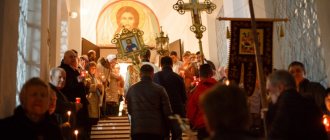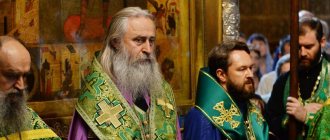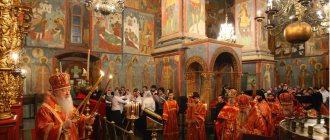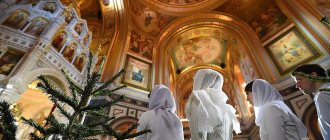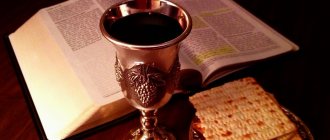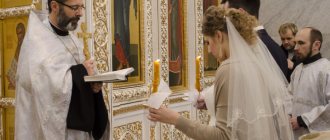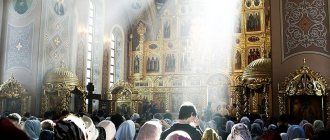The ancient Orthodox tradition instills in every person the belief that every person is the receptacle of a piece of the soul of the Lord. To ask God for something, you don’t have to visit a temple. It is enough to turn to him with a request through prayer words. Church services are the earthly embodiment of faith in the Lord. During liturgical events, you can visit the church for repentance and blessing. Many people need God's constant support. It is important for them to see support, to feel it spiritually, watching the incarnation of the Savior in icons. All services are conducted in accordance with the canons and certain rules.
When are liturgies held?
For Orthodox churches there is no generally accepted rule for conducting divine liturgical events. This is especially true for everyday mornings. Orthodox churches open in the morning. The timing of the liturgy by the clergy directly depends on the wishes of the people who attend such services. If the day falls on a major Christian holiday, then two liturgies are celebrated (morning and evening).
In addition, a prayer service is held on Sunday. The morning service begins at seven o'clock in the morning (sometimes at 8). Some churches shift the prayer time by one hour. That is why the time of Matins and Matins is confirmed with the clergy. Each church has its own time of liturgy. Evening liturgy (vespers) is held from 19-20 hours. In addition, there are night services. They often occur on Great Orthodox holidays, for example, Epiphany, Easter. Processions of the cross are also organized to glorify the Lord.
About Orthodox worship
The days of peace began in the evening (Genesis, chapter 1), so the church service of each day begins with the service of Vespers. Vespers is celebrated according to church rules at 12 o'clock in the afternoon (in our opinion at 18 o'clock). The character of Vespers is peaceful and penitential. By performing this service, we praise the Creator for allowing us to reach the evening, and we thank us for the day we have lived. The creation of the world and Old Testament times are also remembered during this service. Vespers also contains hymns in honor of the celebrated saint or event and from the service of the day of the week. Vespers is most often served separately, independently. According to the regulations, it is preceded by the service of the 9th hour. On the eve of great holidays and Sundays, Vespers is combined with Matins, forming part of the All-Night Vigil. On certain days of the year, Vespers is combined with the Liturgy.
There are three types of Vespers: small, great and daily.
Small Vespers
served on the eve of Sundays and great holidays, when Great Vespers should be combined with Matins, i.e. An All-Night Vigil will be held. Small Vespers always precedes the All-Night Vigil. Now it is rarely used.
Great Vespers
It is served either separately on the eve of holidays or in conjunction with Matins as part of the All-Night Vigil on the eve of Sundays and great holidays.
Everyday Vespers
served when there is no particularly celebrated event.
How to distinguish Great Vespers from Everyday Vespers? A distinctive feature is that at Great Vespers, after the prokemena and the reading of the proverbs (if there are any), there is always a special litany, beginning with the exclamation: “Recite all...” And at the daily Vespers, the special litany is pronounced at the very end of the service and begins with the petition: “Have mercy us, O God...” Also, at Great Vespers, always before the singing of “Quiet Light,” the royal gates are opened and there is an entrance
with a censer.
Entrance
to all-day vespers occurs only on certain days of Lent. At Great Vespers, with the exception of some holidays, the first antiphon of the first kathisma (“Blessed is the man…”) is sung.
When Vespers is served separately, it begins with the exclamation “Blessed is our God...”. And in those cases when it is combined with Matins or the Liturgy, Vespers begins with the exclamations of these services (“Glory to the Holy, Consubstantial, Life-Giving and Indivisible Trinity” or “Blessed is the Kingdom of the Father and the Son and the Holy Spirit”, respectively).
Vespers begins
singing or reading
the opening psalm
: “Bless the Lord, my soul...” (103rd Psalm). This psalm is called the opening psalm because it begins Vespers, and with it the services of the entire day. This psalm is a poetic story about the creation of the world and glorification of the Creator. At the All-Night Vigil, this psalm is sung (according to the rules for the 8th tone), and not read.
After the opening psalm there follows the great litany and the reading of kathismas
. Kathismas are also read at Matins and distributed in such a way that the entire Psalter is read in church during the week. And during the Great Pentecost, the psalter is read in full twice per week. At Great Vespers, as a rule, instead of the poetry of kathisma, the first antiphon of the first kathisma (i.e., the first “Glory”), “Blessed is the man...”, is sung at Vespers. It is supposed to be sung in the 8th tone. In this case, selected verses are usually sung and the rest are read. The singing of each verse is accompanied by the singing of "Alleluia". In the psalms of the 1st antiphon, the Lord Jesus Christ is glorified and His earthly life is depicted. On some days, the reading of kathisma at Vespers is not allowed at all according to the Rule.
Rules for reading the Psalter at a service
The entire character of Vespers is predominantly peaceful and penitential. Therefore, after the opening psalm, the psalter will be sung, in which our needs and sighs are especially clearly revealed. The psalms encourage prayer and kindle the spirit of prayer in the hearts of people. And after the versification of the psalter, there is the singing of psalms in which the soul begins to cry out to the Lord with faith and hope. First, Psalm 140 is sung: “Lord, I have called to You, hear me...”. Then Psalm 141: “With my voice I cried to the Lord” and Psalm 129: “Out of the depths I cried to You, O Lord...” And this singing ends with verses from Psalm 116: “Praise the Lord, all nations, praise Him, all people, for His mercy is established upon us, and the truth of the Lord endures forever.” Along with the verses of these psalms, hymns (stichera) are sung, in which the event of the day or the saint being celebrated is glorified. These stichera are called: “stichera I cried to the Lord.” The number of these stichera is 10, 8 or 6 - according to the charter of the day. All verses of the psalm “I cried to the Lord” and subsequent psalms are sung in the same voice as the stichera. In this case, the first verses are sung without stichera, and starting from a certain verse, stichera are sung (this depends on the number of stichera placed).
After the stichera the chant “Quiet Light”
dedicated to the Lord Jesus Christ. This song continues the praise of God in the Holy Trinity for the sake of the appearance on earth of the Lord, in whose face the “quiet light of holy glory” shone for us, giving life and peace to humanity.
Next the prokeimenon
, that is, a short verse selected from the psalter, which is always followed by several other verses combined with the first. The prokeimenon expresses the meaning of prayers relating to the present day or precedes the reading of the Holy Scriptures and reflects the content of subsequent readings.
After prokemna, on some days proverbs
, i.e. readings from the Holy Scriptures (from the Old Testament or the Apostle), which contain prophecies about the remembered event or explain it or contain praise for the celebrated saint.
Prayer “Grant, O Lord, that this evening we may be preserved without sin”
contains petitions and doxology. It is a continuation of the glorification of That One God in the hymn “Quiet Light.” Before the prayer “Grant, O Lord...” the prayers of Vespers were still partly related to the end of the outgoing day, and after this prayer they are entirely related to the coming day.
After the prayer “Grant, O Lord,” comes the Litany of Petition (“Let us fulfill our evening prayer to the Lord...”), the petitions of which are, as it were, a continuation of the previous prayer. We ask the Lord to spend the evening in peace and without sin, we ask to send down an Angel of God to help us, forgiveness of our sins, we ask the Lord to help us spend all the days of our lives in peace and repentance and grant us a peaceful Christian death and a good answer on the Last Day Court.
After the Litany of Petition at Vespers on the days of great holidays, when the vigil is served, there is a Lithium
. Translated from Greek, “lithium” means fervent, intense prayer. When singing the stichera of a temple or holiday, and then the festive stichera set for singing at the litia, the clergy proceed from the altar into the vestibule of the temple. The vestibule of the temple is the place designated for catechumens and penitents. The Litia is performed in the narthex to depict the fact that the Savior has descended to us on earth, below. And we, standing in the vestibule of the temple, as if before the heavenly gates, beseech the Lord, for we are not worthy to gaze upon the heights of heaven. After the stichera of the litia, the deacon says the prayer “Save, O God, Thy people...”, which contains various petitions for the salvation and blessing of people, calling on the holy saints of God for help. These petitions are interrupted by repeated singing of “Lord, have mercy.” The litany ends with the priest’s prayer “The Lord is abundantly merciful...”, during the reading of which those praying must bow their heads. In this prayer, calling on the Most Pure Mother of God and the saints for help, the priest asks the Lord to accept our prayer, grant us forgiveness of sins, drive away every enemy from us, have mercy and save us.
After the litia, and if the litia was not served, then after the Litany of Petition, stichera on stichera
. They are called so for two reasons: firstly, because before each stichera there is a certain verse from the psalm corresponding to the day or celebration. And secondly, for the reason that the previous stichera at the litia were sung without verses. The stichera on the poem are dedicated to the glorification of a remembered saint or a celebrated event. When two or more celebrations coincide on one day, the Rule prescribes the singing of stichera at the stichera primarily for one celebration and only for “Glory and Now” for another.
After the stichera, the prayer “Now you let go”
. (According to the Charter, it is supposed to be read, but in practice the custom of singing has taken root). When we go to sleep, we are transported in thought to death, the image of which is sleep. And we reverently pronounce with the righteous Simeon the God-Receiver a song of thanks: “Now you let us go.” Saint Simeon the God-Receiver spoke about the permission of the soul from the body, and we (according to the interpretation of Saint Simeon of Thessalonica) ask for the permission of the soul from passions, from enemy temptations and serious mental and physical ailments. We also remember the upcoming outcome.
After the prayer “Now you let us go,” troparia are sung, which are called “dismissal” because they are located before the dismissal (end) of Vespers or Matins. These are, as a rule, troparions of celebrated events. At a vigil, “Rejoice to the Virgin Mary” is most often sung three times, or on great holidays the troparion of the holiday is sung three times. Or “Rejoice, Virgin Mary” is sung along with the troparion of the holiday, as indicated in the Charter for a specific day.
If a vigil with litia is served, then after the troparia the prayer of blessing the loaves is read. The priest blesses the five loaves and vessels with wheat, wine and oil (items necessary to support life) with a special prayer. The five loaves represent the five loaves that Christ multiplied and fed five thousand people. These loaves are divided into small parts and distributed to strengthen those praying. Wine and wheat are also consumed with reverence. Oil is used to anoint people with it.
At the vigil at the end of Vespers, the first part of the 33rd Psalm is sung (about half, up to the words “they will not be deprived of every good”) and the priest blesses the people. The singing of the 33rd Psalm is a natural transition to Matins, as if connecting Vespers with Matins at the All-Night Vigil.
If the vigil is not served, then there is a dismissal of vespers. Dismissal is a special prayer with which the priest ends the service, blessing the people. After the dismissal, at Vespers, Matins and Liturgy, “Multiple Years” is sung - a short prayer for the long life of His Holiness the Patriarch, the ruling bishop, the rector and parishioners of the temple (or monastery) and all Orthodox Christians.
Duration of church service
The time and duration of the service directly depends on the significance of the celebration. For example, on weekdays it can last only 1-2 hours. On Sunday, services last three hours. This rule applies to morning and evening services. Everything is connected with the scale of the holiday.
The evening service may begin at 16:00 (earliest time) or 18:00 (latest time). The duration of the service is 2-4 hours. If a significant church celebration is celebrated on this day, then all services are divided into daily, small and large. In addition, there is an all-night vigil.
Types of services
Regardless of what church is hosting the service or who is conducting it, there are daily, annual, and weekly events. Full-fledged services are organized by monastic monasteries, since monks more diligently adhere to all church canons than others.
In small churches, services are held according to a schedule created by the ministers. Various holidays are celebrated every day, and services dedicated to certain moments are held. For example:
- On Sunday, Little Easter is celebrated, when everyone remembers the moment of the resurrection of Jesus Christ;
- The days of prayer and appeal to the angels fall on Mondays;
- You can contact John the Baptist on Tuesday;
- The traitor of Judas is remembered on Wednesdays, remembering the Cross;
- It is better for people to contact Saint Nicholas on Thursdays, since this day of the week is considered to be the apostolic day;
- On Saturday, believers turn to the Blessed Virgin Mary;
- On Friday, all the sufferings of Jesus Christ are remembered.
If you cannot attend church every day, then you can read the appropriate prayers without leaving home, knowing the schedule. A believer himself has the right to decide when to attend church. For this purpose, church parishes are open almost around the clock.
Conventionally, the entire daily cycle of divine services can be divided into nine equal parts:
- Start taking place at 18:00;
- Compline, consisting of reading prayers in the evenings;
- Midnight Office - begins at midnight;
- Matins, consisting of the first (from 7 am), third (starts at 9:00), sixth (starts at 12:00) and ninth hour, which starts from 15:00.
But the liturgical service, held from 6-9 a.m. to 12 noon, is not part of the church circle of services. At this time, all churches should open their doors to parishioners!
What is an All-Night Vigil in church?
The All-Night Vigil is a ritual held before Orthodox church holidays, combining three services - Great Compline or Vespers, morning service or Matins and the first Hour.
The beginning of the All-Night Vigil, Great Vespers, occurs at sunset, and sometimes lasts into the night hours, smoothly transitioning into the morning service.
The next part of the service, Matins, is performed, according to the Jerusalem Charter adopted in 1695 by the Orthodox Church, in the morning, at dawn.
The third part is a service called the Hours or Hour, dedicated to the remembrance of biblical events.
The All-Night Vigil derives its customs from the evening and night prayers of Jesus Christ and his holy Apostles, but it took shape and took on its current form only under Saint John Chrysostom. By the 9th century, the All-Night Vigil was supplemented by some psalms and prayer books that were included in this sacred rite, accepted and performed to this day by the Russian Church.
Often in large churches and monasteries, on the eve of major holidays - Easter and the Nativity of Christ, the vigil begins at the ninth hour and lasts all night.
Traditionally, the All-Night Vigil takes place before:
- Sunday afternoon;
- twelve and temple festivals;
- special holidays, with the Typikon insignia;
- any church festivals that the rector decides to celebrate.
We bring to your attention an informative article about how the Divine Liturgy is celebrated.
Features of worship services
The peculiarity of the organization of divine services depends on the priest leading the church. For example, Vespers and Matins in villages are organized exclusively by large churches and cathedrals. The difference may lie in the timing and duration of the service. The main liturgical event of any church is the liturgy. At this time, a prayer is read, all parishioners and clergy remember Christ. The liturgy ends with an invitation to pass through the sacrament of Communion. It takes place between 6 and 9 am.
On Sundays there is one service called the Eucharistic. All services are combined into a single one, replacing one another. A recent change in the provisions of the church charter established the holding of Compline exclusively during the beginning of Lent. In addition to large services, the Orthodox Church accepts parallel rituals and sacraments, reading prayer books and akathists.

